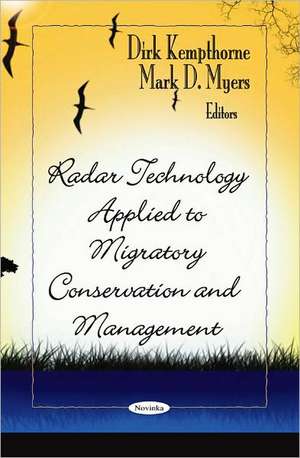Radar Technology Applied to Migratory Conservation and Management
Editat de Dirk Kempthorne, Mark D. Myersen Limba Engleză Paperback – 3 ian 2009
Preț: 303.92 lei
Preț vechi: 408.39 lei
-26% Nou
Puncte Express: 456
Preț estimativ în valută:
58.16€ • 60.50$ • 48.02£
58.16€ • 60.50$ • 48.02£
Carte disponibilă
Livrare economică 24 martie-07 aprilie
Preluare comenzi: 021 569.72.76
Specificații
ISBN-13: 9781606929353
ISBN-10: 1606929356
Pagini: 165
Ilustrații: colour & b/w illus
Dimensiuni: 153 x 229 x 7 mm
Greutate: 0.31 kg
Editura: Nova Science Publishers Inc
ISBN-10: 1606929356
Pagini: 165
Ilustrații: colour & b/w illus
Dimensiuni: 153 x 229 x 7 mm
Greutate: 0.31 kg
Editura: Nova Science Publishers Inc
Cuprins
Preface; Workshop Attendees; Workshop Planning Committee; Workshop Agenda; Executive Summary; Introductory Presentations; History of the USGS-USFWS "Radar Collaborative" and Goals and Focus of the Workshop; Radar as a Tool to Fulfill Information Needs -- Partnering with Stakeholders; Acknowledgments; Abstracts of Workshop Research Presentations; Primer on Radar Biology and Applications to Conservation Issues; Broad-Scale Habitat Relations for Birds; Nocturnal Migration through the Central Appalachians, with Stopovers on Lower Delmarva; Regional Structure in Migratory Patterns across the Southwest; Comment on a New Approach to Modeling Migratory Behavior; Can Artificial Intelligence be used to detect birds in NEXRAD data?; Incorporating NEXRAD Weather Radar into Migration Studies in the Upper Mississippi River System; The Use of Thermal Imaging and Vertically-Pointing Fixed-Beam Radar to Quantify Bird Movements Displayed on Radar; Applications of Pencil-Beam and Tracking Radar to Understanding Flying Biota; Adapting a Military Tracking Radar for Ornithological Research -- The Case of the "Superfledermaus"; Application of WSR-88D (NEXRAD) to Quantify Bird Distributions during Migratory Stopover; Characterizing Bird and Bat Movement Patterns by Using Portable X-Band Radar; Wildlife Radar Research and Development; Past, Present, and Future Uses of Radar for Studying Bats; NEXRAD Program Update; Detection of Birds and Insects with a Polarimetric WSR-88D Radar; Radar Ornithology -- The Past, Present, and Future: A Personal Viewpoint; Radar Workshop -- Key Issues, Themes, and Questions; Agency Needs and Challenges; Radar Technology and Applications -- Technical Questions and Issues; Tools and Resources for Managers and Researchers; Standardization of Protocols; Collaborative Opportunities; Action Items Endorsed by Workshop Participants; Summary Observations from the Workshop; A Research Perspective of the 2006 Radar Biology Workshop; Some Reflections on the Albuquerque Radar Ornithology Workshop; References Cited; Web Sites that Provide Additional Information; Contact Information -- Workshop Participants and(or) Invitees; Index.






